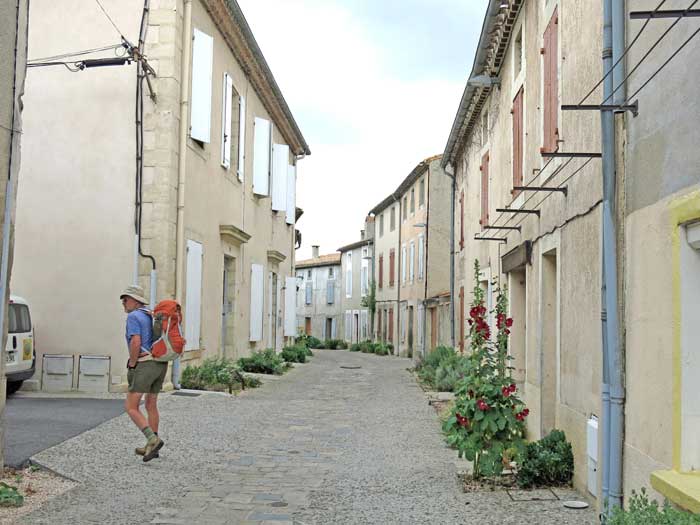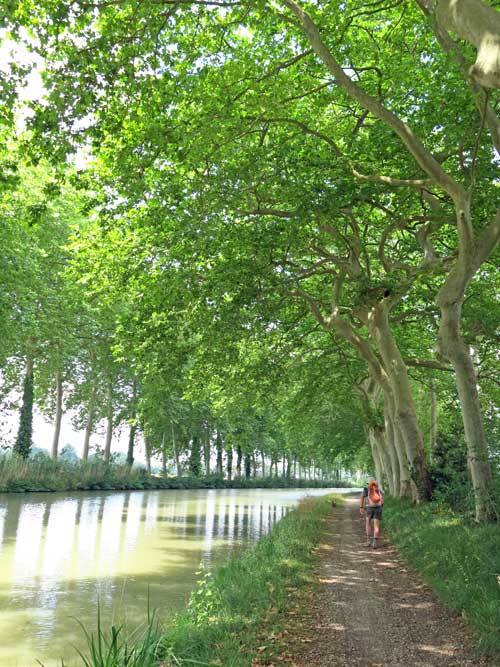Wednesday 17 June 2015
Distance 28 km
Duration 6 hours 0 minutes
Ascent 130 m, descent 93 m
Map 168 of the
We crept out into a chilly dawn. There were a few other campers in residence, but we had seen very little of them during the deluge of the day before, and they were still tucked up in their cabins and caravans when we left at 7:30.
We had found out from Mathieu last night that the bar would not be open in the morning, so we were hoping for breakfast at Bram at the latest, or perhaps even along the canal.
After the rain, the weather had turned cold and I started walking with the full kit of long trousers and fleecy jacket. Keith was hardier.
We passed Chez Mama and took the first turn left onto a tiny road that crossed the fields and then followed the railway line to the farm of Artigues, where it ended.
We walked rather guiltily across the yard in front of the house and scrambled through some bushes to rejoin the canal.
It was peaceful and familiar on the towpath and I soon had to peel off my warm top.
A couple of kilometres later we came to a road bridge, where there was a canal port full of moored boats and beside it a restaurant with tables set out under awnings.
However it was not the time of day for any joy here, so we crossed the bridge and headed for Bram along the D4, or rather along the cycle path beside it.

Apart from the hope of breakfast, we were interested in Bram because it was said to be a prime example of a circulade, a walled village in which the streets form concentric rings around a church. For some reason this circular town plan was only used in a small area in the south-west of France.
It was surprisingly busy on the cycle path, not so much with cyclists as with local people out for a stroll, which seemed to have something to do with the weekly market in the village.
We passed a handsome old pigeonnier standing alone, and then a field of garlic, quite a novelty in this land of vines and wheat. As soon as we crossed the railway line, we were engulfed in a crush of stalls, trucks and people.
Dodging our way along the street, we searched in vain for a bar and ended up turning back and going into the Spar supermarket, where we asked the woman to direct us to a bar. She replied witheringly that there was one immediately opposite (it was hidden behind a charcuterie van).
This was a great relief and a pleasure. We had walked two hours on an empty stomach and were in need of sustenance. The big room inside, with its heavy beamed ceiling and agricultural knick-knacks, was full of people reading the paper or conversing over their coffee.

With our large gran’crèmes, Keith had a pain aux raisins, his favourite pastry, and I had a piece of baguette with some of the butter that we had saved from our legendary hotel breakfast at Capendu.
We emerged much revived, and made a quick visit through the inner circular lanes, to appreciate the odd shape of the place.

Although there had been a Roman town on this spot, the present round village dates from the 12th century.
Like Carcassonne and Castelnaudary, Bram was a centre of Cathar resistance and paid a heavy price for it.
After the village was besieged and overrun by papal forces, a hundred citizens were blinded and disfigured, then roped in a line, led by a man who had one remaining eye, and made to walk to Lastours, a few miles to the north, to terrify the still resistant inhabitants there.
They were then marched off and burned at the stake. This sickening story did nothing for our opinion of organised religion, or of human nature for that matter.
Pressing on, we crossed the railway line on the D33 and turned immediately onto a small patched tar road through open fields. It was odd not to be surrounded by vines.

After a couple of kilometres the road faded into a strip of gently undulating mown grass. On one side was a mass of golden wheat and on the other a crop of young sunflowers – a land of plenty.
We continued in this way until we reached a road, where we met the GR7 and crossed the canal onto the towpath.
About an hour went past and we were swinging along steadily when we had a pleasant surprise at the lock of la Peyruque.

The lock-keeper’s cottage had been converted into a little café, and we were delighted to be the first customers of the day.


Another round of coffee slipped down nicely while we watched a boat negotiating the lock.

Half an hour later, a laden cherry tree provided another unexpected treat.
Soon we came to the place where the canal and the highway converged. We had intended to turn off here to a truckie’s bar, but thanks to the lock café we did not need to.

We continued along the towpath, through the outskirts of Castelnaudary, until the tranquil green shade of the canal opened out onto to a large, ruffled, pewter-grey basin, on the far side of which the town could be seen.
At this point there was a towering lock that rose in four stages to the level of the basin. We discovered later that this basin was the biggest on the canal, and was used to store water for the locks on this side.
We expected to find cafés and bars lining the shore of this lake, but there was nothing until we got to the other end, crossed an old bridge and came to the port.
It was after

Beyond the port, the canal curved away to the left, but there was a road sign to the camping ground pointing straight ahead, so we followed it.
We were getting tired and it was a hot, unedifying uphill walk through the suburbs. At last we arrived.
The camping ground was attractive, but terribly steep, with the canal at the bottom. Every emplacement was a big step down from its neighbour and the access road plunged like a ski run.
We were surprised at the number of small tents around us, all with bikes outside. It was doubly surprising because the camping ground had only opened for the season the day before.
After showers and a rest, we looked around and noticed that, although there was a high mesh fence between the camping ground and the canal, it was easy to get around it.
When the time came to wander back to town, we did this little manoeuvre and found ourselves on a shady path, a great improvement on the road that we had arrived on. This meandered along between the houses and the grassy bank of the canal until we regained the port.
It was still too early to eat, so we walked up the tree-lined street leading from the bridge and soon found a row of bars doing brisk trade.

We sat under a green umbrella, itself under the green canopy of a plane tree, for our customary apéritifs of pastis and rosé.
At about
Castelnaudary is the home of the famous southern dish called cassoulet, and Keith was determined to have one.
According to an explanatory sign, the legend goes that during the Hundred Years’ War, the town was besieged by the English and food supplies ran low.
All that the townsfolk had left were some beans, pork and bacon, so they cooked them all together in a terracotta pot called a cassole, and shared them.
This magical meal gave them enough strength to repel the loathsome invaders and throw them out of the province entirely. (The sign had an English translation, but this last fact was not included in it.)

Our dinner began as usual with a gigantic salad.
After that, Keith had cassoulet, but I had a steak with green peppercorn sauce, my favourite garnish.
We both pronounced our dinners delicious, but mine was so big that I was able to save two sizeable pieces of steak and wrap them in bread rolls for a portable breakfast tomorrow.
Previous day: Carcassonne to Alzonne








